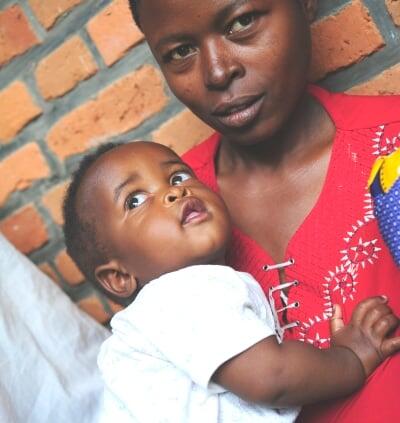The government of Rwanda has developed a national strategic plan for the elimination of mother-to-child transmission (EMTCT) of HIV by 2015, in collaboration with its partners in the fight against HIV.
Rwanda is one of 13 countries in East and Southern Africa (ESA) to develop an EMTCT plan. The Rwandan plan is comprehensive in that it involves all four prongs of EMTCT, and it is currently being scaled up at the district level.
The goal of e-MTCT in Rwanda is to reduce Mother-to-Child-Transmission at 18 months to 2 per cent in 2015. This will be achieved by focusing on the four MTCT prongs, as follows: preventing HIV infection in women, preventing unintended pregnancies in women living with HIV, providing ARV treatment and treating women living with HIV and their families.
Preventing HIV infection in women
The first prong is the primary prevention of HIV infection among women of reproductive age.This aims to prevent men and women of reproductive age, particularly adolescent girls, from contracting HIV. Different strategies will be used, including ABC (Abstinence, Being Faithful and reducing number of sex partners approach, consistent and correct Condom use),prevention and early treatment of sexually transmitted infections (STIs), HIV testing and counselling, male circumcision and prevention of blood-to-blood transmission.
Preventing unintended pregnancies in women living with HIV
The second prong is preventing unintended pregnancies among women living with HIV. This addresses the long-term family planning and contraceptive needs of women with HIV. It includes p reventing HIV transmission from a woman living with HIV to her infant; early ANC visits and routine provision of HIV testing and counselling during ANC, labour, delivery and the postpartum period. The policy encourages involvement of male partners in the national PMTCT programme.
Providing ARV treatment
The third prong involves the provision of triple ARV therapy (HAART).In November 2010, Rwanda adopted the new ARV regimen for the use of ARVs in PMTCT. All HIV-positive pregnant women will receive triple ARV therapy (HAART), starting as early as possible during pregnancy for women eligible for life triple therapy, and from 14 weeks of pregnancy for women not eligible for life treatment.
Treating women living with HIV and families

The fourth prong is providing appropriate treatment, care and support to mothers living with HIV, and also to their children and families.Rwanda promotes the systematic enrolment of all HIV-positive pregnant women and children in the comprehensive treatment, care and support programme and promotes the integration of care and treatment programmes within PMTCT settings.
Accelerating implementation of the EMTCT
After Rwanda’s First Lady, Jeannette Kagame, launched the national EMTCT initiative in May 2011, the Rwanda Biomedical Center (RBC) and partners in PMTCT saw the need to develop a national plan to provide a framework to accelerate the implementation of the EMTCT.
The strategic plan took three months to be developed, from December 2011 to February 2012. The process was led by the HIV clinical prevention unit of the RBC, which actively involved the Technical Working Groups (TWG) for clinical prevention, district health workers, and networks of People Living with HIV (PLHIV), among others.
The development of the strategic plan had four stages.
Establishment of technical working sub-groups
Firstly, four technical working sub-groups were set up in July 2011 to look into the performance of prevention of mother-to-child transmission (PMTCT), including its achievement, gaps and challenges, and to outline priority interventions and key indicators for EMTCT. RBC and its partners then carried out a gap analysis for the PMTCT programme.
Comprehensive bottleneck analysis of the PMTCT programme
Consultative meeting for the development of national EMTCT strategy
Thirdly, several consultative meetings were organized with members of the Technical Working Groups to identify priority programme areas for accelerated EMTCT programme implementation. RBC organized a strategic planning workshop in December 2011 to share the findings of the analysis with partners and district health workers and to carry out an analysis of evidence-based bottlenecks for the PMTCT programme, as well as to define key outcomes and outputs for the EMTCT strategic framework. Over 40 participants from the Institute of HIV and Disease Prevention and Control (IHDPC), the Rwandan Biomedical Center (RBC), Technical Working Group (TWG) members, district health workers, and representatives from other governmental institutions attended the workshop.
Involving networks of people living with HIV in the EMTCT strategy
Finally, networks of women and girls living with HIV were consulted at a meeting, to ensure that people living with HIV (PLHIV) networks contributed to the development of the EMTCT strategy. This was organized by IHDPC and UNAIDS. More than 25 network members attended.
The next stage is to develop an EMTCT plan in all 30 districts, which will be endorsed by the district authorities.




